Pau d’Arco Beats Back Candida
The typical pathogen that overgrows during a period of off the wagon eating is Candida – a term that refers to a large family of yeasts (one celled fungi) that under normal circumstances, harmlessly inhabit the tissues of humans. This is because a balanced intestinal tract from mouth to colon contains a preponderance of beneficial bacteria that keep Candida in check.
When not enough beneficial bacteria are present in a given body tissue to keep Candida under control, Candida transforms from a harmless state into an invasive species. Candida overgrowth can occur in many tissues of the body such as oral candidiasis known as thrush, the scalp as dandruff, fungus toenails, or vaginal yeast infections.
Cutting off Candida’s goodies by eliminating the junk allows the beneficial microbes to re-exert their authority and bring gut pathogens back into subjection before they start causing health issues.
They won’t go quietly, I can tell you!
Once you get over the hump which in my experience is the first 24-72 hours, you will likely find being back on the wagon comfortable again at last. You won’t be craving treats or junk every few hours and your blood sugar will stabilize back into a normal steady routine without excessive peaks or valleys.
The good news is that herbs can provide much needed assistance during those initial difficult hours when the gut pathogens like Candida are clamoring for their sugar fix and you are struggling to put an end the feeding frenzy.
The best herb I’ve ever used for this purpose is Pau d’arco, also known as Tabebuia.
The Pau d’arco herb is derived from the inner bark of a beautiful, large tree that is native to the rainforests of Central and South America. It will grow in any warm, humid clime, and I actually have two of these trees, Tabebuia impetiginosa, growing in my front yard.
While Pau d’arco has been used as a medicine to counteract fungal overgrowth for centuries, science is also validating these anecdotal observations. The Brazilian Journal of Biology found in 2010 found that Tabebuia avellanedae, one tree species that is the source of the Pau d’arco herb, does indeed exert an inhibitory effect on yeasts.
Continue here for the original article
Source:
thehealthyhomeeconomist.com
draxe.com
Image: wikimedia



